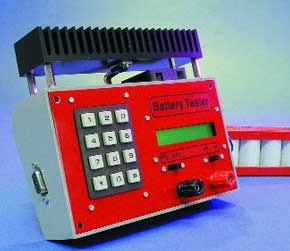Battery Discharger/Capacity Meter (1)
design and control module

This is a MEMBER ONLY article. You need a subscription to read this article.
- Unlimited access to online Member Only articles
- 3 new editions Elektor Magazine (digital)
- More than 5000 Gerber files
- 20% member discount on e-books (at elektor.com)
- 10% member discount on Products (at elektor.com)
Available from €5.33 per month.
What is Members Only
Elektor is committed to providing high-quality content on electronics, catering to tens of thousands of paying members. As part of this commitment, Elektor has launched Premium, an initiative that offers exclusive online articles to members sometimes even before they appear in the magazine.
Every day, members can access in-depth articles that showcase the best of Elektor's premium content.
This initiative aims to reward members with early access. Once logged in, members can easily enjoy this exclusive content and engage in discussions about featured projects. While Premium adds to the existing resources available, Elektor will continue to provide a wealth of free information.
Join the Elektor community today to take advantage of Premium and other benefits!
Materials
Gerber file
CAM/CAD data for the PCB referred to in this article is available as a Gerber file. Elektor GREEN and GOLD members can exclusively download these files for free as part of their membership. Gerber files allow a PCB to be produced on an appropriate device available locally, or through an online PCB manufacturing service.
Elektor recommends the Elektor PCB Service service from its business partner Eurocircuits or AISLER as the best services for its own prototypes and volume production.
The use of our Gerber files is provided under a modified Creative Commons license. Creative Commons offers authors, scientists, educators and other creatives the freedom to handle their copyright in a more free way without losing their ownership.
Component list
Resistors:
R1 = 2O2
R2 = fuse, 1AT (time lag) Picofuse (e.g., Farnell 446-944)
R3-R12 = 1kOhm
R13,R18 = 27kOhm
R14 = 100kOhm *
R15 = 120kOhm
R16 = 1kOhm 5
R17 = 220kOhm
R19,R20 = 4kOhm 7
R21,R22 = 10kOhm
P1 = 5kOhm preset
Capacitors:
C1,C2 = 100µF 25V radial
C3,C10-C13 = 100nF ceramic
C4,C5 = 27pF
C6 = 1µF 63V radial*
C7 = 4nF7, lead pitch 5mm
C8 = 4µF7 63V radial
C9 = 470pF
Semiconductors:
D1*,D3-D7 = BAT85
D2 = 1N4148
IC1 = 4001
IC2 = ST62T65, programmed, order code 010201-41
IC3 = 4066
IC4 = ST24C16
IC5 = 4094
Miscellaneous:
K1-K4 = 12 x 3-way pinheader
K5 = 2-way pinheader
K6 = 9-way sub-D socket female), angled pins, PCB mount
K7 =14-way SIL-header
JP1 = 3-way pinheader with jumper
S1 = pushbutton type D6 (ITT/Schadow)
X1 = 8MHz quartz crystal
Bz1 = AC buzzer
LCD dot matrix module, 1×16 characters, 80×36×10 mm (e.g., Farnell # 142-542)
14 way female PCB connector for LCD
PCB, order code 010201-1 (see Readers Services page), supplied with discharger board 010201-2)
*) not fitted when using ST62T65 type C



Discussion (0 comments)